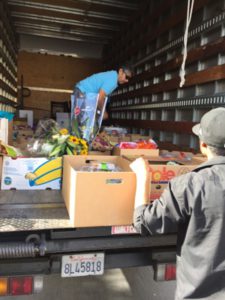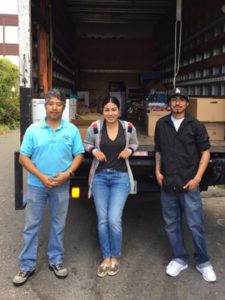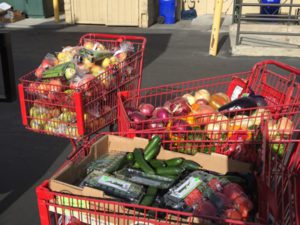The Life of Food, the Food of Life
April 20, 2017
Written by: Guest contributor, Lisa Shaffer
Lisa Shaffer and her husband, Steve Bartram, are long-time CRC supporters. Lisa served on the Encinitas City Council from 2012-2016.
A Quiz:
 1. How often does a CRC truck pick up food donations from one or more local grocery stores?
1. How often does a CRC truck pick up food donations from one or more local grocery stores?
a. Daily
b. Twice a week
c. Weekly
2. How many pounds of perishable food does the CRC Food and Nutrition Program distribute each month?
a. 20,000
b. 50,000
c. 100,000
3. What is the approximate dollar value of the volunteer hours every month in the food and nutrition program?
a. $10,000
b. $40,000
c. $20,000
(Answers at bottom)
Behind the Scenes at CRC’s Food Distribution Program
I recently tagged along with CRC staff members, Jose and Yanira, on a daily food pickup run. I started my day with a bowl of organic oatmeal, which I prepared in my comfortable kitchen. Not everyone has that luxury. About 50 households are served every day (nearly 400 each month) by the Community Resource Center’s food and nutrition programs – the “bread line” and the food pantry, which also includes emergency food packets. And there are lots of moving parts that make it possible for them to be served. Let’s take a look behind the scenes.
Once food nears its expiration date, or its packaging has been damaged, stores no longer can sell it. Throwing it away is wasteful, expensive, and bad for the environment. Fortunately, most of the surplus food still has real value and can make a huge difference in the life of a family that is food-insecure. The partnership between the CRC and these local stores extends the life of the food and helps our neighbors in need.
Jose cheerfully starts this day at the Target in Encinitas Ranch, where we picked up boxes of packaged food, fresh meat and poultry, and household goods. There were many boxes of bagged salads, some frozen items, and household sundries. Target, which tracks its donations as part of its corporate social responsibility mandate, logs in how much they donate and gets a receipt. Jose estimates the weight and type of food donated and tracks it through an application on his cell phone for CRC monitoring purposes.
The next stop is Ralphs, where CRC picks up three times each week. Each department identifies donations every morning, storing their offerings on site on the days when there is no pickup. Jose logs it all in while separating perishables and non-perishables. We made one more stop at nearby Trader Joe’s. Unfortunately, since CRC does not have a refrigerated truck, once there are fresh and frozen items onboard, he has to get them back to CRC’s storage area quickly. Then he was back on the road to Lazy Acres and Gelsons for more.
At Trader Joe’s, there were grocery carts waiting, filled with bell peppers, red onions, mesh bags of avocados,clementines, and much more. We do our own boxing and then load the items into the truck. There is a grocery cart full of fading flowers, but we are told that on Fridays the flowers go to Meals on Wheels. We head back to the CRC to offload these donations. Items are sorted for proper storage by Food Pantry volunteers, and distributed to clients through the Food and Nutrition program.
The partnership between the CRC and these local stores extends the life of the food and helps our neighbors in need.
 From the Truck to the Food Distribution Center
From the Truck to the Food Distribution Center
It takes a lot of moving parts to get those onions and that box of cereal into the hands of a family in need. But that basket of food can make all the difference. By providing not just calories, but nutritious food, CRC is helping people get and stay healthy, and freeing up limited funds so participants can make their rent payment or pay for the bus to get to a job. For the grocery stores, the donation represents a real monetary saving as well as a contribution to the community. In one of the many examples of the triple bottom line (economics, community and environment), by reducing waste, the stores save money. By caring about the community, they are helping potential customers live healthier lives where they can support themselves. And by eliminating additional waste, they are reducing the need for more landfills and avoiding greenhouse gas emissions from methane released from decomposing food.
By providing not just calories, but nutritious food, CRC is helping people get and stay healthy, and freeing up limited funds so participants can make their rent payment or pay for the bus to get to a job.
 Over half of the food distributed at CRC comes from the “fresh rescue” program, which is the produce and other refrigerated products picked up daily. Additionally, each Tuesday, Jose picks up the high-quality organic produce, donated by Coastal Roots Farm –Leichtag Foundation. These donations serve the nearly 50 people who come weekly to the daily morning “bread line,” open to all individuals who are not yet enrolled in case management. They are limited in the amount of food they receive. Another approximately 150 weekly participants receive the services of full food distribution, available to those who are receiving case management services. These folks get an allocation based on the number of people in the household and are able to “shop” with the assistance of a volunteer, picking items that fit within their allotted point distribution. The fresh rescue allotment is based on what’s available that day and the size of the family. The volunteers working in CRC’s Food and Nutrition programs represent over $80,000 in food benefits in any given month, with over 800 volunteer hours per month, over $250,000 in volunteer labor hours per year.
Over half of the food distributed at CRC comes from the “fresh rescue” program, which is the produce and other refrigerated products picked up daily. Additionally, each Tuesday, Jose picks up the high-quality organic produce, donated by Coastal Roots Farm –Leichtag Foundation. These donations serve the nearly 50 people who come weekly to the daily morning “bread line,” open to all individuals who are not yet enrolled in case management. They are limited in the amount of food they receive. Another approximately 150 weekly participants receive the services of full food distribution, available to those who are receiving case management services. These folks get an allocation based on the number of people in the household and are able to “shop” with the assistance of a volunteer, picking items that fit within their allotted point distribution. The fresh rescue allotment is based on what’s available that day and the size of the family. The volunteers working in CRC’s Food and Nutrition programs represent over $80,000 in food benefits in any given month, with over 800 volunteer hours per month, over $250,000 in volunteer labor hours per year.
The food and nutrition program helps families and individuals avoid homelessness, and achieve self-sufficiency. CRC is able to serve more participants for less money, thanks to the generosity of the participating stores and volunteers.
[helpme_button style=”three-dimension” size=”large” bg_color=”#00A8A1″ txt_color=”#fff” outline_skin=”#444444″ outline_hover_skin=”#fff” icon=”theme-icon-video” url=”https://crcncc.org/food-nutrition-services/” target=”_self” align=”left” id=”Button ID” margin_bottom=”15″]Learn more about CRC’s Food Distribution Programs [/helpme_button]
Quiz answers: 1.a; 2.b; 3.c
